We’ll have better luck with the Ursids. This meteor shower tends to fall under the radar for two reasons. It’s a relatively minor event, averaging a mere 10 meteors hourly (although brief outbursts of 50 or more per hour have been reported), and it occurs at a time of year when most of us are caught up in the holiday rush. I’ve never witnessed an Ursid meteor for the aforementioned reasons, plus clouds have foiled my efforts in recent years. Weather permitting, I’ll be outside the evening of December 22, reclining in a lawn chair and bundled up against the cold as I gaze northward toward the shower’s radiant: Beta (β) Ursae Minoris. A bright gibbous Moon won’t rise until nearly midnight, so I’ll have several hours to capture my first Ursid. Because I’m competitive, I challenge you to an Ursid meteor count — who sees the most in a single hour. Any takers?
Visit Astronomy.com to read my review of the book The Stargazing Year by Charles Laird Calia. A delightful, fact-filled, month-by-month romp through our night skies, as well as a humorous account of the author’s attempt at constructing an observatory, The Stargazing Year is a must-read for novice and experienced skywatchers alike. After you buy Calia’s book, be sure your subscription to Astronomy will carry you through until the end of 2006.
Finally, pick up a copy of our annual guide, Explore the Universe 2006. As the New Year arrives, read Calia’s chapter on January. Use the all-sky map from the January issue of Astronomy to locate the sky sights Calia describes and the January notes from Explore the Universe 2006 for enrichment. Then, go outside and get to know the heavenly wonders that greet our eyes that month. Do the same in February and ensuing months.
I recommend this tactic for the beginner eager to learn about our night sky’s stars and constellations. But you veterans might enjoy reviewing old night-sky friends as Calia presents them.
As I reflect on the past year, I’m amused by the fact that the biggest astronomical event of 2005 never happened — at least, not in 2005. Early last summer, several readers e-mailed me inquiring about an unusually close August opposition of Mars they had heard about. One report claimed that, to the unaided eye, Mars would appear as large as the Full Moon! Locally, several acquaintances, including my brother, asked me about this story. I was surprised because Mars was due for an opposition, but not until November. Were the heavens suddenly coming undone? A little detective work provided the answer.
Apparently, descriptions of the close opposition of August 2003, still out there on the Internet, confused people who didn’t read the date carefully. The result was a false rumor — NASA ultimately called it the “Mars hoax” — that a great opposition would occur in August 2005. Lesson: Read carefully any astronomical info gleaned from the Internet. Better yet, check out Astronomy.com for the real story.
Next month: We explore the Moon and take a “power trip.” Clear skies.










